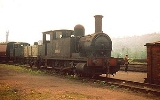
NLR Class 75
Encyclopedia
The North London Railway Class 75 is a class of 0-6-0
T steam locomotive
.
Thirty were built to a design by J.C. Park from 1879 to 1905. They were designed for shunting
the NLR
's docks and were very compact but powerful engines. This made them suitable later for transfer onto the Cromford and High Peak Railway
in Derbyshire
, and some were sent north. They worked there until they were displaced by J94 "Austerity"
0-6-0STs.
and renumbered in the 2600s. The remaining locomotives were also transferred at a later date and renumbered in the 2800s. All passed to the London, Midland and Scottish Railway
on grouping
, and were renumbered 7503–7532. In 1934 the surviving engines were renumbered by adding 20,000 to their numbers. In 1948 the 14 surviving engines passed to British Railways on nationalisation and were renumbered 58850–58863.
. However it is stored at shed awaiting overhaul.
0-6-0
Under the Whyte notation for the classification of steam locomotives, 0-6-0 represents the wheel arrangement of no leading wheels, six powered and coupled driving wheels on three axles, and no trailing wheels...
T steam locomotive
Steam locomotive
A steam locomotive is a railway locomotive that produces its power through a steam engine. These locomotives are fueled by burning some combustible material, usually coal, wood or oil, to produce steam in a boiler, which drives the steam engine...
.
Thirty were built to a design by J.C. Park from 1879 to 1905. They were designed for shunting
Dock shunter
A Dock shunter, or "Dock tank", is a locomotive used for shunting wagons in the vicinity of docks. It is usually of 0-4-0 or 0-6-0 wheel arrangement and has a short wheelbase and large buffers...
the NLR
North London Railway
The North London Railway was a railway company that opened lines connecting the north of London to the East and West India Docks. The main east to west route is now part the North London Line. Other lines operated by the company fell into disuse, but were later revived as part of the Docklands...
's docks and were very compact but powerful engines. This made them suitable later for transfer onto the Cromford and High Peak Railway
Cromford and High Peak Railway
The Cromford and High Peak Railway in Derbyshire, England, was completed in 1831, to carry minerals and goods between the Cromford Canal wharf at High Peak Junction and the Peak Forest Canal at Whaley Bridge -Origins:...
in Derbyshire
Derbyshire
Derbyshire is a county in the East Midlands of England. A substantial portion of the Peak District National Park lies within Derbyshire. The northern part of Derbyshire overlaps with the Pennines, a famous chain of hills and mountains. The county contains within its boundary of approx...
, and some were sent north. They worked there until they were displaced by J94 "Austerity"
LNER Class J94
The London and North Eastern Railway J94 Class is a class of steam locomotive that was formed when 75 former "Austerity" 0-6-0STs were purchased by the LNER in 1946 from the War Department.- Overview :...
0-6-0STs.
Numbering
They were originally numbered 15–18, 61–66, 75–80, 91–95, 104, 107, 111, 115–116, 119, 121–123. In 1909 the nine locomotives numbered above 100 were transferred to the London and North Western RailwayLondon and North Western Railway
The London and North Western Railway was a British railway company between 1846 and 1922. It was created by the merger of three companies – the Grand Junction Railway, the London and Birmingham Railway and the Manchester and Birmingham Railway...
and renumbered in the 2600s. The remaining locomotives were also transferred at a later date and renumbered in the 2800s. All passed to the London, Midland and Scottish Railway
London, Midland and Scottish Railway
The London Midland and Scottish Railway was a British railway company. It was formed on 1 January 1923 under the Railways Act of 1921, which required the grouping of over 120 separate railway companies into just four...
on grouping
Railways Act 1921
The Railways Act 1921, also known as the Grouping Act, was an enactment by the British government of David Lloyd George intended to stem the losses being made by many of the country's 120 railway companies, move the railways away from internal competition, and to retain some of the benefits which...
, and were renumbered 7503–7532. In 1934 the surviving engines were renumbered by adding 20,000 to their numbers. In 1948 the 14 surviving engines passed to British Railways on nationalisation and were renumbered 58850–58863.
Preservation
One, BR 58850 (ex LMS 27505, LMS 7505, LNWR 2650, NLR 116) – the last of the class to be withdrawn, in 1960 – has been preserved and has run on the Bluebell RailwayBluebell Railway
The Bluebell Railway is a heritage line running for nine miles along the border between East and West Sussex, England. Steam trains are operated between and , with an intermediate station at .The railway is managed and run largely by volunteers...
. However it is stored at shed awaiting overhaul.

